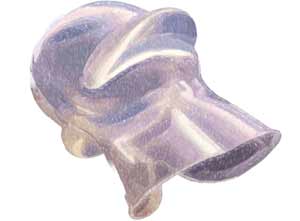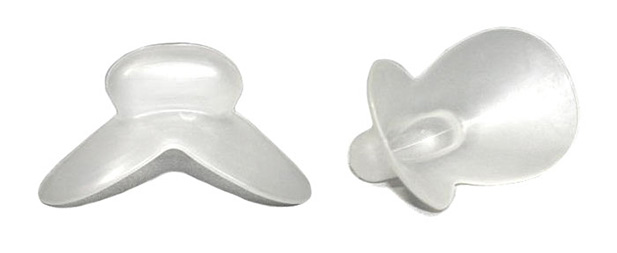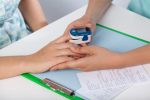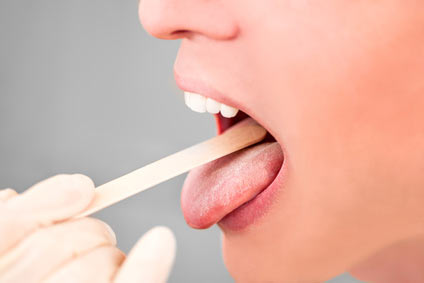Tongue Retaining Device TRD
Sleep Apnea Tongue Device - Benefits and Sife Effects

According to clinical studies, a tongue retaining device can help improve snoring and obstructive sleep apnea (OSA) without the need of using a CPAP machine.
In this page you'll discover how the apnea tongue device works, how effective it is, how to use it properly, and what are its side effects.
How Does a Tongue Retaining Device Works?
Simply stated, the TRD device (also known as tongue stabilizing device - TSD) holds the tongue forward during sleep to prevent it from obstructing the airway.
By retaining the tongue, the retaining device is increasing the three-dimensional airway space from your mouth, which is one of the most effective ways of keeping the airway open during sleep.
This tongue stabilizing device is intended to pull and retain the tongue in an advanced position during sleep so that the tongue would not collapse into the airway against the pharyngeal wall due to decreased muscle tone.
Do you need a dentist to use the apnea tongue device?
Most of the oral tongue devices does not require a specialist fitting by a dental professional, because they don't attach to the teeth and they are designed to be simple to use by every patient.
Do you need a TRD to treat sleep apnea?
Some patients with obstructive sleep apnea can drastically reduce their sleep disorder by using the tongue retaining device.
How do you know if the TRD works for you?
The Tongue Retaining Device is useful for patients with:
- snoring,
- mild and moderate obstructive sleep apnea,
- big tongue, or a tongue muscle that becomes too relaxed during sleep,
- large tonsils or long uvula,
- hypothyroidism: due to lack of thyroid hormone, patients tend to have a larger tongue, as well as increased fat deposits in the tissues of the upper airway.
Note: If the patient's tongue does not extend beyond the lips, the tongue retaining device will not be a suitable treatment option!
How Effective is a Tongue Retaining Device?
There are many clinical studies where you can verify the effectiveness of tongue stabilizing devices. Some of the most relevant studies are:
1. The effects of a nonsurgical treatment for obstructive sleep apnea
- one of the fist studies about tongue retaining devices, where 20 male patients with obstructive apnea were fitted with the device. After the first night, there was a significant reduction of apnea episodes.
2. Predicting response to the TRD for sleep apnea syndrome
In this study 16 patients with obstructive sleep apnea were tested for the effectiveness of the TRD. The result was 69% positive, where 11 patients from 16 were successfully treated.
This study also discovered that patients with substantial worsening of apnea episodes while sleeping in the supine position were more responsive to the oral devices than those equally affected in both sleeping positions.
3. The TRD: Efficacy and Side Effects in Obstructive Sleep Apnea Syndrome
84 patients with obstructive apnea were tested monitored for a period of 5 years. The study reveals encouraging results:
- the apnea-hyponea index decreased significantly from 38 to 14 when the patients were wearing the TRD,
- the intensity of snoring decreased by 61%,
- the Epworth Sleepiness Scale decreased from 9 to 6.
The tongue retaining device was not effective for patients with nasal obstruction, and the compliance rate after 5 years of monitoring was 52%.
4. Toward a treatment logic for sleep apnea: The place of the TRD
20 subjects were studied, and the treatment with the TRD was 83% successful.
Furthermore, patients with more severe apnea episodes in supine position and with their body weight not greater than 50% above the ideal weight are more prone to be successfully treated with TRD.
Examples of Tongue Retaining Devices
Good Morning Snore Solution

One of the most famous tongue stabilizing device is Good Morning Snore Solution, which is an anti-snoring and sleep apnea aid approved by the FDA as a medical device.
The tongue device is made from a soft medical silicone designed increase the comfort of the patient.
You don't need to have perfect teeth to attach the oral device, and you don't need a specialist to help you fitting properly because it does not require custom fitting or routine adjustment.
The device is indicated for everyone, even for people who wear full dentures.
To find if Good Morning Snore Solution will work for you, try this simple 10 seconds test as shown in the following video:
Tongue Positioner
Nose Breathe Tongue Positioner is a new tongue stabilizing oral device, where the tongue is held this time at the roof of the mouth and retained by a naturally lip seal and tongue suction due to the negative pressure of the oral cavity.
This negative pressure only appears when the person breathes through the nasal passages (nasal breathing).
When the tongue is placed at the roof of the mouth, it prevents the tongue from falling into the back of the throat, increasing the space for the nasal passages.
How to Use The Tongue Retaining Device?
To proper use the TRD, please follow these tips:
- Before use, rinse the TRD under warm water. This helps ease the device onto your tongue.
- Push your tongue gently into the oral device until it touches the sides of the device by gently squeezing the upper and lower ends of the bulb between the forefinger and thumb.
- By using a gentle repeated pumping action, the tongue will be drawn gently into the TRD.
- Draw the tongue into the TRD until it's firmly attached. Make sure it's not too tight or too loose.
For more tips on wearing and cleaning your TRD, especially Good Morning Snore Solution, please check this video (the effort of the reviewer to create this video is highly appreciated):
...and the follow up:
Side Effects of the Tongue Retaining Device
Excessive Salivation
The main problem with these oral devices is excessive salivation, mainly during the first week of use. The good news is that salivation will eventually subside in time, so you should keep using the oral device without interruption.
If you find the salivation to be a problem, place a towel over the pillow, but try to continue the therapy.
Difficulty Swallowing
This can be due to the tongue that is too stretched. Try moving tongue out of device to give tongue more flexibility. As the salivating reduces, the difficulty swallowing will disappear as well.
Furthermore, with practice you can learn how to swallow with the device in your mouth.
Bottom line... According to the polysomnographic data from clinical studies, the tongue retaining device has a substantial effect on reducing the number and duration of apnea episodes during sleep in patients with obstructive sleep apnea.
The effectiveness of TRD is much lower in patients with severe sleep apnea (AHI over 30), but it seems to be a good alternative to those in the mild and moderate range (AHI between 5 to 30).
Home › Dental Devices for Sleep Apnea › Tongue Retaining Devices







